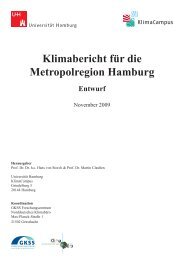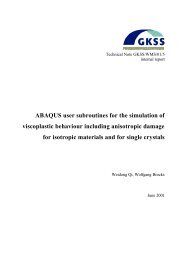Dynamics and Vulnerability of Delta Systems - loicz
Dynamics and Vulnerability of Delta Systems - loicz
Dynamics and Vulnerability of Delta Systems - loicz
Create successful ePaper yourself
Turn your PDF publications into a flip-book with our unique Google optimized e-Paper software.
chemical gradients <strong>and</strong> other non-linear distributions that influence how particular restoration<br />
actions will contribute to the overall delta system integrity <strong>and</strong> function. <strong>Delta</strong> restoration will not<br />
be effective if approached from a less systematic deployment <strong>of</strong> ecosystem creation, remediation<br />
or other attempts to ‘engineer’ delta processes <strong>and</strong> ecosystems.<br />
A delta system is economically sustainable if the output <strong>of</strong> goods <strong>and</strong> services is greater than the<br />
economic inputs or subsidies required for production. Analysis <strong>of</strong> economic sustainability is<br />
complicated because economic activities supported by deltas, like shipping <strong>and</strong> fisheries, are<br />
<strong>of</strong>ten counted elsewhere <strong>and</strong> human populations dependent on deltas <strong>of</strong>ten do not live in deltas.<br />
Humans have lived in <strong>and</strong> around delta for millennia because <strong>of</strong> the benefits provided by deltas.<br />
In fact, it seems likely that most early civilizations arose in deltas <strong>and</strong> lower river valleys because<br />
<strong>of</strong> the rich food resources (Day et al. 2007). Major rivers brought transport <strong>and</strong> trade <strong>and</strong> thus<br />
economic wealth to populations living in <strong>and</strong> around deltas. <strong>Delta</strong>s <strong>and</strong> lower river valleys also<br />
provide rich resources <strong>of</strong> food <strong>and</strong> fiber <strong>and</strong> were places <strong>of</strong> productive agriculture. The costs <strong>of</strong><br />
development in deltas were more than <strong>of</strong>fset by the economic gains. Thus deltas were<br />
economically sustainable because <strong>of</strong> the subsidy provided by the physical <strong>and</strong> ecological energies<br />
<strong>of</strong> deltas. Many deltas, however, have degraded due to human impacts such as levees <strong>and</strong><br />
impoundments <strong>and</strong> their net economic yield has decreased or is projected to decrease (e.g.<br />
Milliman et al. 1989). This has resulted in the substitution <strong>of</strong> human capital for natural capital<br />
with the benefits resulting from the use <strong>of</strong> human capital being more easily directed to certain<br />
groups or individuals. For example, bounding rivers by levees improved navigation <strong>and</strong> flood<br />
control thus subsidizing <strong>and</strong> benefiting those involved in these activities. However, a severe cost<br />
was incurred in that natural capital, i.e. the sediments in the river were no longer used to maintain<br />
the delta leading to loss <strong>of</strong> wetl<strong>and</strong>s <strong>and</strong> the services they provide. Thus, the costs were<br />
externalized to those benefiting from the wetl<strong>and</strong>s, i.e. fishermen, <strong>and</strong> the public commons.<br />
Templet (1998) showed that increasing human subsidies, which result from externalities, leads to<br />
poorer environmental <strong>and</strong> socioeconomic conditions <strong>and</strong> less sustainability. If, instead <strong>of</strong><br />
substituting industrial energies for natural capital energy, we were to use the natural capital <strong>and</strong><br />
industrial energies in reaching economic goals, then we would expend less to achieve more <strong>and</strong><br />
be more sustainable. Practically, this means using man-made energies to engineer the system to<br />
allow the river's water <strong>and</strong> sediment <strong>and</strong> other energy pulses to sustain <strong>and</strong> build wetl<strong>and</strong>s that<br />
then produce goods <strong>and</strong> services at lower cost.<br />
Increasingly, more economists are incorporating goods <strong>and</strong> services with the environmental<br />
conditions <strong>and</strong> costs incurred with uses (Costanza et al. 2002, Daly 1994). Central to this thesis is<br />
the idea that economic estimates that incorporate environmental degradation reveal true costs <strong>of</strong><br />
operating in those environments. This could ultimately result in better environmental management<br />
as a result <strong>of</strong> long-term economic incentives. In the case <strong>of</strong> deltas, determining economic<br />
stability is intimately tied to the existence <strong>of</strong> the delta itself, thus depending on geomorphic <strong>and</strong><br />
ecological sustainability which are, in turn, <strong>of</strong>ten dependent on economic decisions.<br />
• What are the human vulnerabilities in delta systems? How could the concepts from the best<br />
<strong>and</strong> most comprehensive vulnerability literature outlining theory <strong>and</strong> practice (Hewitt 1983,<br />
Lewis 1999, Oliver-Smith 1986, Wisner et al. 2004) be applied for deltas in general <strong>and</strong> for<br />
specific delta case studies?<br />
• How could delta health be defined, described, <strong>and</strong> improved? How do ecosystem <strong>and</strong> human<br />
health interact in delta regions <strong>and</strong> how could that be influenced for mutual benefit?<br />
43





